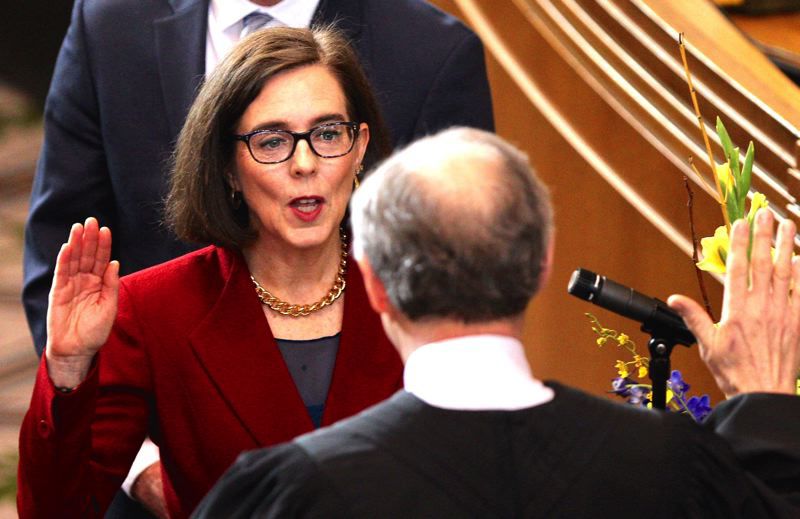Brown takes oath as Oregon’s elected governor
Published 8:00 am Monday, January 9, 2017

- JAIME VALDEZ/PAMPLIN MEDIA GROUP - Gov. Kate Brown takes the oath of office Monday from Oregon Supreme Court Justice Thomas Balmer. Brown was elected in November to finish the remaining two years of former Gov. John Kitzhaber's term. She succeeded him to the post when he resigned in February 2015.
SALEM — Gov. Kate Brown was sworn in for the first time as elected governor Monday, after serving in the position for nearly two years.
The governor used her inaugural address to unveil her legislative agenda for the year.
Trending
“Under my leadership, we will continue to move Oregon forward,” Brown told an audience in the Oregon House of Representatives chamber.
Brown, as secretary of state, ascended to the governorship in February 2015 when then-Gov. John Kitzhaber stepped down amid a scandal over consulting contracts awarded to his fiancée, Cylvia Hayes. In Oregon, where there is no lieutenant governor, the secretary of state is next in line.
She became the first openly bisexual governor in national history.
Brown was elected in November with an overwhelming majority to complete that last two years of Kitzhaber’s four-year term, defeating Republican challenger, Dr. Bud Pierce of Salem.
During her speech Monday, Brown called on Oregon lawmakers to set aside their differences to work together this session to tackle Oregon’s $1.7 billion revenue shortfall. “We have to come together and know that we are all on the same side,” Brown said.
She also said Oregonians should resist any attacks on civil rights in the wake of New York billionaire Donald J. Trump’s election as president.
Trending
“We must guard against prejudice based on race, ethnicity, religion or belief,” Brown said to applause. “We must not allow the rights of any one person or class of people to be degraded in any way. We must stand for our veterans. We must defend the rights of LGBTQ Oregonians.”
Brown also released her priorities for the 79th legislative assembly, which convenes Feb. 1. Top priorities are the state’s high school graduation rate, a transportation funding package, measures to keep firearms out of the hands of high-risk individuals and expansion of health care subsidies to all children.
R evenue
Her agenda omitted specific proposals to raise taxes to address the state’s $1.7 billion revenue shortfall, an issue expected to be at the center of lawmaker debate during the 2017 session. However, she continued her call for better management of state pension investments, and she called on lawmakers to work together to find solutions to revenue problems.
Voters in November rejected Measure 97, which would have raised $3 billion a year in corporate sales taxes.
Brown said she has been having “informal conversations” with members of the business community and labor community about potential tax reforms.
“I believe we cannot move Oregon forward without adequate and stable revenue for key basic services, and I will tell you that members of the business community that I have spoken with over the last several months agree, so now we have to figure out the right solution that doesn’t provide further burdens for our working families across the state and also ensures that our economy continues to thrive in every single corner,” Brown said.
E ducation
Brown’s agenda includes creating a $20 million graduation equity fund to replicate successful practices from around the state and address chronic absenteeism and expanding mentoring and professional development for teachers.
“My top priority will be to work to improve Oregon’s high school graduation rate,” Brown said.
About 74 percent of Oregon students graduate within four years, the third worst rate in the nation.
G u n control
In July, Brown announced she would attempt to close two loopholes in state law on firearm possession.
One proposal would close the so-called “Charleston” loophole, which allows a gun purchase to move forward if law enforcement hasn’t determined the buyer’s eligibility within three days. She also is seeking to close the “boyfriend loophole,” which expands the types of relationships that qualify for gun dispossession when convicted of domestic violence charges.
Her agenda does not include another proposal she unveiled in July to ban the future purchases of expanded capacity gun magazines.
“I was committed to working with community activists and gun control advocates that believe in common sense legislation, and frankly we struggled to get broad support to move forward on that legislation, but it doesn’t mean that I am giving up,” Brown said.
C a ll for bipartisanship
Brown opened her speech by invoking Republican Gov. Tom McCall’s call during his 1967 inaugural address to govern in a spirit of bipartisanship.
“It is in that spirit that I address you, the members of the 79th Oregon Legislative Assembly; and it is that spirit that I address all Oregonians,” Brown said.
Her comments came shortly after Republicans cried foul over Brown’s decision to change her proposal to place a public records advocate in the secretary of state’s office after Republican Dennis Richardson won election to the position. Instead, Brown decided to propose placing the advocate in the Department of Administrative Services, which is under her control.
Brown was sworn in at about noon by Oregon Supreme Court Justice Thomas Balmer. In her subsequent inaugural address, she gave a nod to elected officials in the chamber and singled out state Rep. Vic Gilliam, who has continued his service as a state representative despite his battle with ALS and confinement to a wheelchair.
Former governors Barbara Roberts and Ted Kulongoski attended Brown’s inauguration ceremony. Kitzhaber and Neil Goldschmidt, both former governors whose terms were touched by scandal, were absent from the event.
Brown’s inauguration capped the swearing in of several new lawmakers in the House of Representatives and Senate and the reading of more than 1,500 bills introduced for the February policymaking session.





